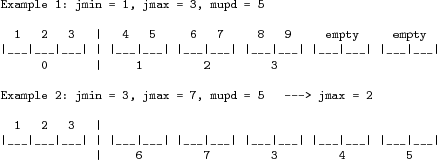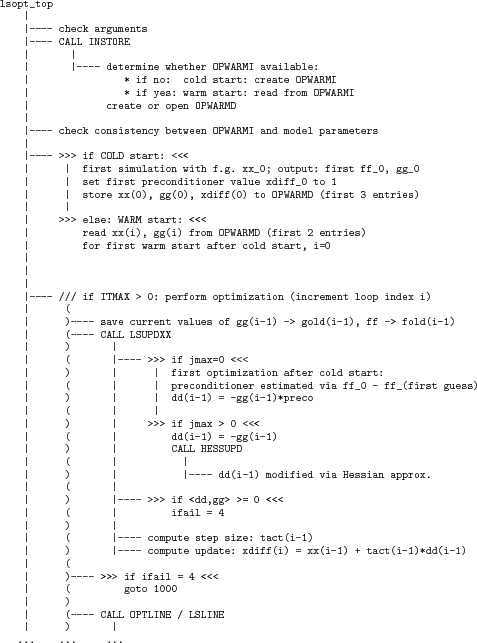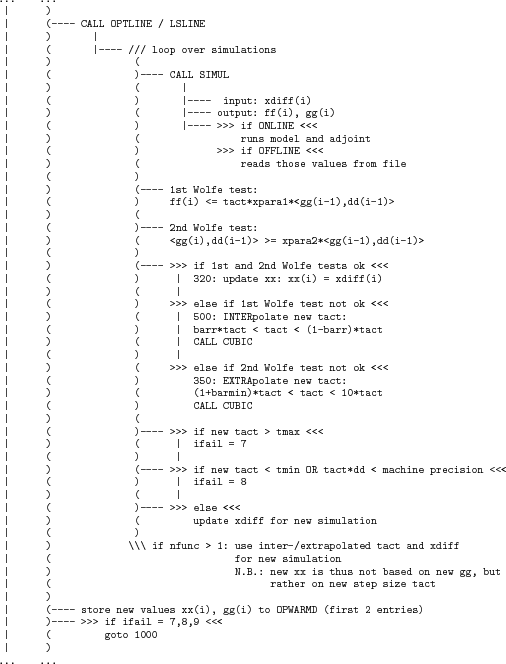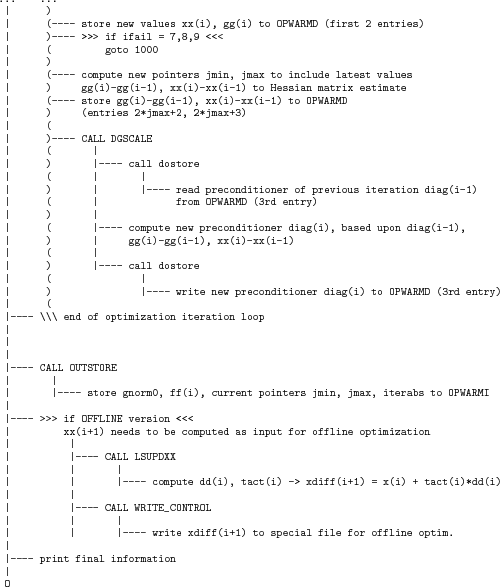|
|
|
|




Next: 9. Under development
Up: 8.5 The line search
Previous: 8.5.2 The online vs.
Contents
Subsections
- itmax: controls the max. number of iterations
- nfunc: controls the max. number of simulations
within one iteration
From one iteration to the next the descent direction changes.
Within one iteration more than one forward and adjoint
run may be performed.
The updated control used as input for these simulations uses the same
descent direction, but different step sizes.
From one iteration to the next the descent direction dd changes using
the result for the adjoint vector gg of the previous iteration.
In lsline the updated control
serves as input for
a forward and adjoint model run yielding a new gg(i,1).
In general, the new solution passes the 1st and 2nd Wolfe tests
so xdiff(i,1) represents the solution sought:
If one of the two tests fails,
an inter- or extrapolation is invoked to determine
a new step size tact(i-1,2).
If more than one function call is permitted,
the new step size is used together
with the "old" descent direction dd(i-1)
(i.e. dd is not updated using the new gg(i)),
to compute a new
that serves as input
in a new forward and adjoint run, yielding gg(i,2).
If now, both Wolfe tests are successful,
the updated solution is given by
In order to save memory both the fields dd and xdiff
have a double usage.
- xdiff
-
- in lsopt_top: used as x(i) - x(i-1) for Hessian update
- in lsline: intermediate result for control update
x = x + tact*dd
- dd
-
- in lsopt_top, lsline: descent vector, dd = -gg
and hessupd
- in dgscale: intermediate result to compute new preconditioner
- NUPDATE
max. no. of update pairs (gg(i)-gg(i-1), xx(i)-xx(i-1))
to be stored in OPWARMD to estimate Hessian
[pair of current iter. is stored in
(2*jmax+2, 2*jmax+3)
jmax must be > 0 to access these entries]
Presently NUPDATE must be > 0
(i.e. iteration without reference to previous
iterations through OPWARMD has not been tested)
- EPSX
relative precision on xx bellow which xx should not be improved
- EPSG
relative precision on gg below which optimization is
considered successful
- IPRINT
controls verbose (>=1) or non-verbose output
- NUMITER
max. number of iterations of optimisation;
NUMTER = 0: cold start only, no optimization
- ITER_NUM
index of new restart file to be created (not necessarily = NUMITER!)
- NFUNC
max. no. of simulations per iteration
(must be > 0);
is used if step size tact is inter-/extrapolated;
in this case, if NFUNC > 1, a new simulation is performed with
same gradient but "improved" step size
- FMIN
first guess cost function value
(only used as long as first iteration not completed,
i.e. for jmax <= 0)
Two files retain values of previous iterations which are
used in latest iteration to update Hessian:
- OPWARMI: contains index settings and scalar variables
| n = nn |
no. of control variables |
|
fc = ff |
cost value of last iteration |
|
isize |
no. of bytes per record in OPWARMD |
|
m = nupdate |
max. no. of updates for Hessian |
|
jmin, jmax |
pointer indices for OPWARMD file (cf. below) |
|
gnorm0 |
norm of first (cold start) gradient gg |
|
iabsiter |
total number of iterations with respect to cold start
|
- OPWARMD: contains vectors (control and gradient)
|
entry |
name |
description |
|
1 |
xx(i) |
control vector of latest iteration |
|
2 |
gg(i) |
gradient of latest iteration |
|
3 |
xdiff(i),diag |
preconditioning vector; (1,...,1)
for cold start |
|
2*jmax+2 |
gold=g(i)-g(i-1) |
for last update (jmax) |
|
2*jmax+3 |
xdiff=tact*d=xx(i)-xx(i-1) |
for last update (jmax)
|
Figure 8.1:
Examples of OPWARM file handling
 |
Figure 8.2:
Flow chart (part 1 of 3)
 |
Figure 8.3:
Flow chart (part 2 of 3)
 |
Figure 8.4:
Flow chart (part 3 of 3)
 |




Next: 9. Under development
Up: 8.5 The line search
Previous: 8.5.2 The online vs.
Contents
mitgcm-support@mitgcm.org
| Copyright © 2006
Massachusetts Institute of Technology |
Last update 2018-01-23 |
 |
|















